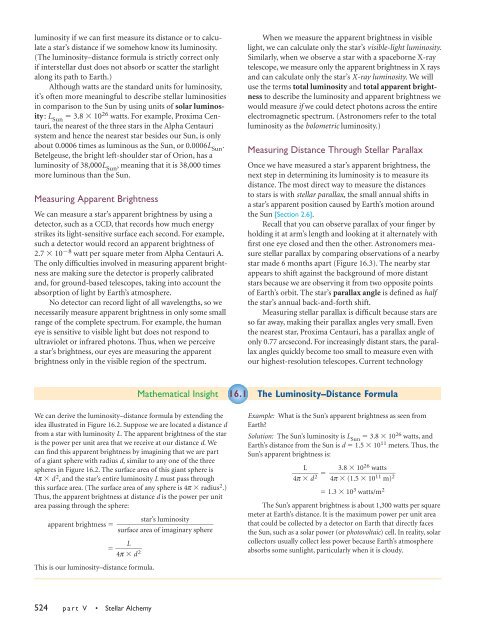Chapter 16--Properties of Stars
Chapter 16--Properties of Stars
Chapter 16--Properties of Stars
Create successful ePaper yourself
Turn your PDF publications into a flip-book with our unique Google optimized e-Paper software.
luminosity if we can first measure its distance or to calculate<br />
a star’s distance if we somehow know its luminosity.<br />
(The luminosity–distance formula is strictly correct only<br />
if interstellar dust does not absorb or scatter the starlight<br />
along its path to Earth.)<br />
Although watts are the standard units for luminosity,<br />
it’s <strong>of</strong>ten more meaningful to describe stellar luminosities<br />
in comparison to the Sun by using units <strong>of</strong> solar luminosity:<br />
L Sun 3.8 10 26 watts. For example, Proxima Centauri,<br />
the nearest <strong>of</strong> the three stars in the Alpha Centauri<br />
system and hence the nearest star besides our Sun, is only<br />
about 0.0006 times as luminous as the Sun, or 0.0006L Sun .<br />
Betelgeuse, the bright left-shoulder star <strong>of</strong> Orion, has a<br />
luminosity <strong>of</strong> 38,000L Sun , meaning that it is 38,000 times<br />
more luminous than the Sun.<br />
Measuring Apparent Brightness<br />
We can measure a star’s apparent brightness by using a<br />
detector, such as a CCD, that records how much energy<br />
strikes its light-sensitive surface each second. For example,<br />
such a detector would record an apparent brightness <strong>of</strong><br />
2.7 10 8 watt per square meter from Alpha Centauri A.<br />
The only difficulties involved in measuring apparent brightness<br />
are making sure the detector is properly calibrated<br />
and, for ground-based telescopes, taking into account the<br />
absorption <strong>of</strong> light by Earth’s atmosphere.<br />
No detector can record light <strong>of</strong> all wavelengths, so we<br />
necessarily measure apparent brightness in only some small<br />
range <strong>of</strong> the complete spectrum. For example, the human<br />
eye is sensitive to visible light but does not respond to<br />
ultraviolet or infrared photons. Thus, when we perceive<br />
a star’s brightness, our eyes are measuring the apparent<br />
brightness only in the visible region <strong>of</strong> the spectrum.<br />
We can derive the luminosity–distance formula by extending the<br />
idea illustrated in Figure <strong>16</strong>.2. Suppose we are located a distance d<br />
from a star with luminosity L. The apparent brightness <strong>of</strong> the star<br />
is the power per unit area that we receive at our distance d. We<br />
can find this apparent brightness by imagining that we are part<br />
<strong>of</strong> a giant sphere with radius d, similar to any one <strong>of</strong> the three<br />
spheres in Figure <strong>16</strong>.2. The surface area <strong>of</strong> this giant sphere is<br />
4p d 2 , and the star’s entire luminosity L must pass through<br />
this surface area. (The surface area <strong>of</strong> any sphere is 4p radius 2 .)<br />
Thus, the apparent brightness at distance d is the power per unit<br />
area passing through the sphere:<br />
apparent brightness <br />
L<br />
<br />
4p d 2 <br />
This is our luminosity–distance formula.<br />
524 part V • Stellar Alchemy<br />
When we measure the apparent brightness in visible<br />
light, we can calculate only the star’s visible-light luminosity.<br />
Similarly, when we observe a star with a spaceborne X-ray<br />
telescope, we measure only the apparent brightness in X rays<br />
and can calculate only the star’s X-ray luminosity. We will<br />
use the terms total luminosity and total apparent brightness<br />
to describe the luminosity and apparent brightness we<br />
would measure if we could detect photons across the entire<br />
electromagnetic spectrum. (Astronomers refer to the total<br />
luminosity as the bolometric luminosity.)<br />
Measuring Distance Through Stellar Parallax<br />
Once we have measured a star’s apparent brightness, the<br />
next step in determining its luminosity is to measure its<br />
distance. The most direct way to measure the distances<br />
to stars is with stellar parallax, the small annual shifts in<br />
a star’s apparent position caused by Earth’s motion around<br />
the Sun [Section 2.6].<br />
Recall that you can observe parallax <strong>of</strong> your finger by<br />
holding it at arm’s length and looking at it alternately with<br />
first one eye closed and then the other. Astronomers measure<br />
stellar parallax by comparing observations <strong>of</strong> a nearby<br />
star made 6 months apart (Figure <strong>16</strong>.3). The nearby star<br />
appears to shift against the background <strong>of</strong> more distant<br />
stars because we are observing it from two opposite points<br />
<strong>of</strong> Earth’s orbit. The star’s parallax angle is defined as half<br />
the star’s annual back-and-forth shift.<br />
Measuring stellar parallax is difficult because stars are<br />
so far away, making their parallax angles very small. Even<br />
the nearest star, Proxima Centauri, has a parallax angle <strong>of</strong><br />
only 0.77 arcsecond. For increasingly distant stars, the parallax<br />
angles quickly become too small to measure even with<br />
our highest-resolution telescopes. Current technology<br />
Mathematical Insight <strong>16</strong>.1 The Luminosity–Distance Formula<br />
star’s luminosity<br />
<br />
surface area <strong>of</strong> imaginary sphere<br />
Example: What is the Sun’s apparent brightness as seen from<br />
Earth?<br />
Solution: The Sun’s luminosity is LSun 3.8 1026 watts, and<br />
Earth’s distance from the Sun is d 1.5 1011 meters. Thus, the<br />
Sun’s apparent brightness is:<br />
L<br />
<br />
4p d 2 <br />
1.3 103 watts/m2 3.8 1026 watts<br />
<br />
4p (1.5 1011 m) 2<br />
The Sun’s apparent brightness is about 1,300 watts per square<br />
meter at Earth’s distance. It is the maximum power per unit area<br />
that could be collected by a detector on Earth that directly faces<br />
the Sun, such as a solar power (or photovoltaic) cell. In reality, solar<br />
collectors usually collect less power because Earth’s atmosphere<br />
absorbs some sunlight, particularly when it is cloudy.
















